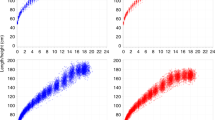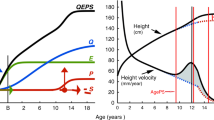Abstract
Objective: The influence of weight excess reduction on height and height velocity of obese subjects should be evaluated on the basis of appropriate standards, since the pattern of growth of obese subjects is different from that of normal weight subjects.
Design, subjects and measurements: Height, weight and triceps skinfold thickness were recorded from 17 987 school subjects (9256 males and 8731 females), 3–18 y of age, from three provinces of central Italy, and a growth reference curve of height was constructed. Using BMI (as computed using the tables of Rolland-Cachera et al) and triceps skinfold thickness, normal-weight subjects (NWS) and obese subjects (OS) were identified and specific reference curves (mean±s.d. every sixth month of age) were developed for both groups. Centiles of height were also calculated for OS. Various (2–4) measurements of height in school subjects were performed and a graph of height velocity (HV) was constructed in NWS and in OS using the JPPS method. The yearly mean ±s.d. of HV was also calculated, based on square root transformed data (in order to realise a Gaussian distribution), deriving from successive measurements in total subjects, in NWS and in OS. The z-scores of height and of the square root of HV were calculated in 217 obese subjects (125 males and 92 females) before and during a weight excess reduction programme (WERP). Obese subjects in WERP who showed a reduction of z-score of BMI were considered as ‘responsive’; those who either maintained or showed an increase of z-score of BMI were considered as ‘non-responsive’. Obese subjects in WERP were followed for 1–4 y, giving the following results: 0–1 y, 142 responsives and 75 non-responsives; 0–2 y, 76 responsives and 33 non-responsives; 0–3 y, 35 responsives and 30 non-responsives; 0–4 y, 24 responsives and 18 non-responsives.
Results: Compared to NWS, OS showed a significantly greater HV in 4–9 y males and in 4–8 y females, but in older children the pubertal spurt was reduced and more precocious. As a result, the height of OS, which was greater in 3–13 year-old males and in 3–11.5 year-old females, subsequently showed a reduction, as compared to that of NWS, in 16–18 year-old males and in 13–18 year-old females. In both responsive and non-responsive groups of obese subjects in WERP, the z-scores of height showed a reduction during WERP when evaluated using the reference curve of the total school population. In contrast, when their growth was evaluated according to the obese-specific reference curve, no significant variation was observed comparing both z-scores before and during the WERP.
Conclusions: More appropriate information on the growth of obese subjects may be obtained when evaluating the height and HV according to obese-specific reference standards from the same population of origin. Adopting this modality, no significant variation of height resulted during WERP in obese children.
This is a preview of subscription content, access via your institution
Access options
Subscribe to this journal
Receive 12 print issues and online access
$259.00 per year
only $21.58 per issue
Buy this article
- Purchase on Springer Link
- Instant access to full article PDF
Prices may be subject to local taxes which are calculated during checkout
Similar content being viewed by others
Author information
Authors and Affiliations
Rights and permissions
About this article
Cite this article
Falorni, A., Galmacci, G., Bini, V. et al. Using obese-specific charts of height and height velocity for assessment of growth in obese children and adolescents during weight excess reduction. Eur J Clin Nutr 53, 181–188 (1999). https://doi.org/10.1038/sj.ejcn.1600695
Received:
Revised:
Accepted:
Published:
Issue Date:
DOI: https://doi.org/10.1038/sj.ejcn.1600695
Keywords
This article is cited by
-
Weight loss and the Effect on Stature in Children During a Residential Intervention Program
Obesity (2008)
-
Leptin serum concentrations predict the responsiveness of obese children and adolescents to weight excess reduction program
International Journal of Obesity (2000)



